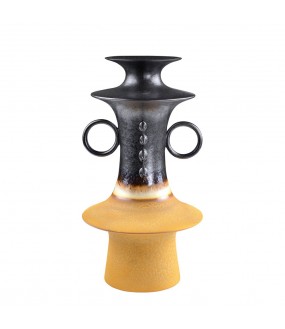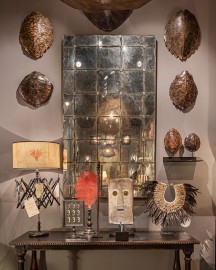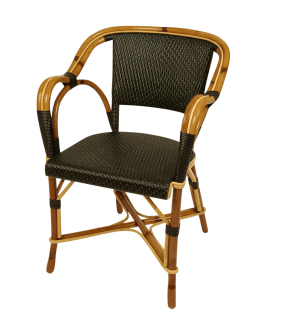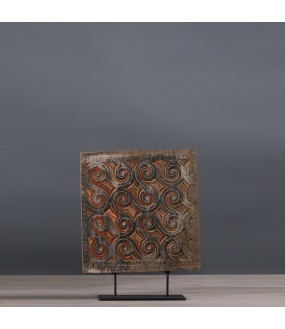STYLES
La Maison Arteslonga likes to explore and bring together styles and eras in a desire for harmony and softness.
Modernist
Minimalist Raw
Luxury Movie Star 50s
Timeless
Orientalist
Baroque
Proustian Era
Greco-Roman
Cabinet of Curiosities
Ethnic Chic
-
Ceramic Vase Kenzo H49cm
€290.01Decorate your interior with the ethnic style Kenzo vase in bronze and yellow colors, entirely made of ceramic by hand.
This vase, embellished with handles, with atypical and generous shapes, is a decorative element that combines ethnic charm with the trendiest color of earthenware.
Ideal to place on a large solid wood table, a shelf or on the floor, its dimensions will make this vase a major part of your decoration.
The height of the Kenzo vase is 49 cm for 26 cm in diameter.
Please note that it is not waterproof and cannot contain water. Color variations or shadings are typical of this handcrafted glazed ceramic.
-
Glazed Ceramic Boxe Yuto H37cm
€240.00The Yuko box...
A box like no other in bronze and yellow colors, entirely made of hand-enamelled ceramic. A Japanese ethnic style.
This box, embellished with a lid with atypical and generous shapes, is a decorative element that combines ethnic charm with the color of the most trendy earthenware.
Ideal to place as a decoration on a table, a console or a shelf, its dimensions will make this atypical earthenware box an original piece of your decoration.
The height of the Yuko box is 36.5 cm for 17.5 cm in diameter.
Attention, the variations of colors or shades are typical of this handcrafted enamelled ceramic.
-
Kozo Ceramic Vase H55cm
€230.01Decorate your interior with the ethnic style Koso vase in bronze and yellow colors, entirely made of ceramic by hand.
This vase, embellished with handles, with atypical and generous shapes, is a decorative element that combines ethnic charm with the trendiest color of earthenware.
Ideal to place on a large solid wood table, a shelf or on the floor, its dimensions will make this vase a major part of your decoration.
The height of the Kozo vase is 55 cm for 15 cm in diameter.
Please note that it is not waterproof and cannot contain water. Color variations or shadings are typical of this handcrafted glazed ceramic.
-
Parisian Coffee Mirror, 1900-20s
€1,560.00Parisian Coffee or Restaurant Mirror or the years 1900-1920.
A nice sized 120cm height by 90 cm.
A beautiful decorative mirror to recreate a spirit of curiosity cabinet. -
Handmade Enameled Ceramic Lamp - H130cm
€640.00Handmade enameled ceramic living room lamp with large round cylindrical shade orange color. This lamp with its shade totalizes 130cm of height.
A beautiful living room lamp for a warm interior. To put on the floor, on a console, a buffet, a shelf, in an alcove ... it will easily find its place in your interior decoration to bring its elegance and its wink to the 70s.
A very beautiful presence for this large living room lamp in enameled ceramic.
-
Black Rattan Armchair, Made to Order
€1,014.00Vintage 1900 style armchair but light (6kg), fully woven in shiny synthetic fiber (Rilsan) on a wicker structure.
This armchair can be personalized in its weaving and colors.
This woven rattan armchair in the colors of your desires can be stacked and resists in all climates.
It is presented to you here in these colors: Shiny Black – Pantone 426, Shiny Pine Green – Pantone 3485
This rattan armchair will embellish your kitchen, your living room, your terrace, your veranda or your restaurant.
Overall height: 82cm
Overall width: 58cm
Overall depth: 53cm
Weight: 6kg
Seat height: 45cm
Armrest height: 70cm
Seat width: 43 cm wide seat
Indoor/Outdoor: Semi-outdoor
Stackability: Stackable
Weaving fiber: Brilliant (Rilsan)
Structure material: dark riton (Malacca)
Possibility of weaving the Riverside armchair in your colors, a made-to-measure production in synthetic fiber with the color of caning and the weaving of your choice (see photos).
Rattan is a material with extraordinary properties with limits. Rattan is a vine of the Palm race, which grows in very humid or even swampy equatorial forests.
With its siliceous skin like glass, this extremely solid and light vine is particularly resistant to humidity, as are tropical woods, teak or others.
But this resistance has its limits. Exposed to rain, rattan resists very well for a whole day or even a few days. But if this rain continues for too many hours, the humidity will gradually penetrate the Rattan, and day after day the material kept damp will end up slowly degrading and losing its resistance qualities.
The physical limits of rattan imply precautions for use. On the terraces of Parisian cafes, the chairs can last for decades while they are often in the rain all day for long periods. But they are piled up every night under cover and can thus dry out.
More generally, rattan can withstand rain for long hours without compromising its longevity, but must be able to dry regularly.
In practice, rattan furniture can stay outside throughout the "summer season", the weather is hot and rather dry, continuous rains exceptionally last more than three or four days and Rattan withstands such rains without degrading.
But as soon as the season advances, the temperature drops, there is a lot of condensation and humidity, the Rattan will gradually become humid, the long and heavy rains accentuating this degradation. In practice, these are sensitive situations by the sea.
It is then imperative to put the seats under shelter, a ventilated shelter to avoid progressive humidification as soon as the "bad season" arrives, in practice from mid-October to mid-March for a continental climate.
The alternative if you want to use your Rattan furniture all year round, is to put it away daily, every evening, as Parisian terraces do.
In summary, 2 main principles to respect:
During the winter season (October 15 to March 15 in Europe) in all climates: the furniture must be stored “dry”. It can however be left outside during the day, but must imperatively be put in the dry during the night.
During the "beautiful season", the rest of the time, the Rattan can remain permanently outside.
However, if a lasting rain arrives, the Rattan should only be left in this rain for two or three days at the most, before putting the furniture in the dry place so that it can dry. He only takes it out once the rain has stopped (In any case, a terrace cannot be used in the rain).
En savoir plus sur ce texte sourceVous devez indiquer le texte source pour obtenir des informations supplémentaires
Envoyer des commentaires
Panneaux latéraux
-
Primitive Panel Toraja - South Indonesia
€240.00Beautiful Primitive wall panel, finely carved and painted bright colors worn by time.
Distinctive architectural element from traditional houses in southern Indonesia.
-
Small Iconic Stele
€360.00From the Kingdom of Queen of Sheba, exceptional small iconic stele, current reproduction of pieces that existed dating from the 3rd/1st century BC.
These steles are the remains of forgotten civilizations of the South Arabian Peninsula and more particularly of Yemen, a thousand-year-old country with dreamlike landscapes and unique architecture in the world.
For many, it remains the land of incense, “caravan routes” and the lands of the sultans.
Hand-carved from sandstone by our artisans, these steles were originally pillars. Rectangular in shape, with the effigy of stylized faces, they were sometimes engraved with the name of their owners.
These faces, always represented from the front with a straight nose, topped with eyebrow arches in strong relief, were framed by almond-shaped eyes and a small mouth with pursed lips.
Their stylization is remarkably abstract, their primitive appearance has inspired more than one artist of the modern era.
Patinas and wear due to time are skillfully reproduced in our workshops in a natural way.
They are each presented on a matte black “museum style” base.









